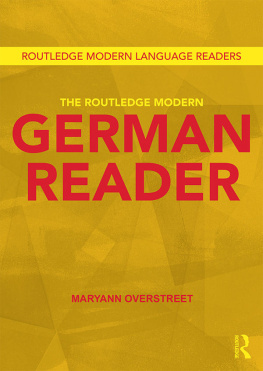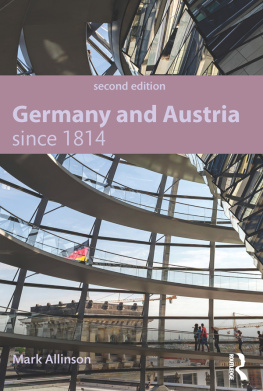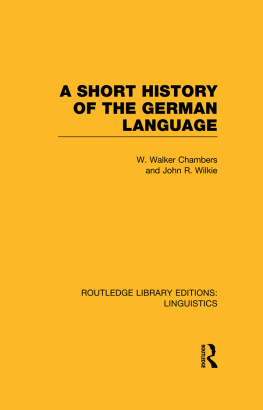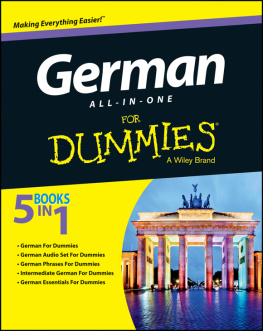
A History of the German Language through Texts
This lively and thought-provoking book will fill a gap in the study of the history of the German language and will provoke discussion of the way in which history is currently taught.
Christopher Wells, University of Oxford
A History of the German Language through Texts examines the evolution of German, from the Early Medieval period to the present day.
The book offers an alternative to traditional histories of the German language by focusing on the evidence provided in primary sources. Written in a lively and accessible style, it provides commentaries on over forty German texts. Each text is translated, set firmly in its sociolinguistic context and analysed in terms of its key linguistic features. Texts range from eighth century translations of the Lords Prayer, through medieval medical texts and early modern cookbooks to modern scientific texts and internet chatroom messages posted on September 11, 2001.
The book also includes a glossary of technical terms and abbreviations, a summary of the main changes in each historical period, a guide to reference material and suggestions for further reading.
A History of the German Language through Texts is essential reading for students of German, Linguistics or Philology.
Christopher Young is Lecturer at the University of Cambridge and Fellow of Pembroke College, where he is Director of Studies in Modern and Medieval Languages. His publications include Narrativische Perspektiven in Wolframs Willehalm (2000) and Ulrich von Liechtensteins Frauenbuch (2003). Thomas Gloning is Lecturer in German Linguistics at the University of Marburg, Germany. His publications include Organisation und Entwicklung historischer Wortschtze (2003) and Rheinfrnkisches Kochbuch (um 1445) (1998).
A History of the German Language through Texts
Christopher Young
and Thomas Gloning

First published 2004 by Routledge
2 Park Square, Milton Park, Abingdon, Oxon, OX14 4RN
Simultaneously published in the USA and Canada
by Routledge
711 Third Ave, New York, NY 10017
Routledge is an imprint of the Taylor & Francis Group
2004 Christopher Young and Thomas Gloning
Index Jane A. Horton
Typeset in Baskerville by
Florence Production Ltd, Stoodleigh, Devon
All rights reserved. No part of this book may be reprinted or reproduced
or utilised in any form or by any electronic, mechanical, or other means,
now known or hereafter invented, including photocopying and recording,
or in any information storage or retrieval system, without permission in
writing from the publishers.
British Library Cataloguing in Publication Data
A catalogue record for this book is available from the British Library
Library of Congress Cataloging in Publication Data
Gloning, Thomas.
A history of the German language through texts/Thomas Gloning
and Christopher Young.
p. cm.
Includes bibliographical references and index.
1. German languageHistory. 2. German languageHistorySources.
I. Young, Christopher, 1967 II. Title.
PF3075.G56 2003
ISBN 0415183316
Contents
Illustrations
Tables
Phonetic symbols and abbreviations
| * | In historical contexts, reconstructed item (we have used this before reconstructed PIE words and morphemes, but not before phonemes); in non-historical contexts, an ungrammatical or non-occurring item. |
| > | becomes |
| < | derives from |
| / / | phonemic representation |
| [ ] | phonetic representation |
| < > | orthographic representation |
| subscript represents PIE syllabic consonants |
| - | length (except in MHG) |
| ^ | length in MHG, due to well established principles of normalization in the discipline. |
Representation of graphemic, phonetic and phonemic units
For historical stages of the language, we refer to phonemes as they have been traditionally dealt with in historical grammars of German. For NHG we generally follow the symbols of the International Phonetic Alphabet. Where both systems are required in the same analysis, we mark the IPA explicitly. For ease of orientation we reproduce below a chart of NHG vowel phonemes and a more general chart of consonant phonemes, both of which are based on Dudens use of IPA.
examples:
| /i:/ | viel |
| /I/ | Tisch |
| /e:/ | legen |
| /:/ | Bren |
| /:/ | Bett, htte |
| /a:/ | Strae |
| /a/ | Gasse |
| /o:/ | so |
| // | Stock |
| // | schn |
| // | zwlf |
| /u:/ | Mue |
| // | mu |
| /y:/ | mde |
| /Y/ | hbsch |
| /ai/ | sei |
| /au/ | sau |
| /y/ | neu |
| // | all e |


(Adapted from Johnson 1988: 84)
Abbreviations
| 1 Linguistic terms |
| Du | Dutch |
| C | Central |
| CG | Central German |
| DWb | Deutsches Wrterbuch |
| E | English |
| E | East |
| ECG | East Central German |
| EUG | East Upper German |
| ENHG | Early New High German |
| F | French |
| Fri | Frisian |
| G | German |
| Gmc | Germanic |
| Go | Gothic |
| Gk | Greek |
| GSR | Germanic Stress Rule |
| H | High |
| HG | High German |
| IE | Indo-European |
| IPA | International Phonetic Alphabet |
| L | Latin |
| L | Low |
| LG | Low German |
| M | Middle |
| MHG | Middle High German |
| mlat. | Middle Latin |
| MLG | Middle Low German |
| N | North |
| NHG | New High German |
| PGmc | Proto-Germanic |
| PIE | Proto-Indo-European |
| O | Old |
| OCS | Old Church Slavonic |
| OE | Old English |
| OF | Old French |
| OFri | Old Frisian |
| OHG | Old High German |
| OIc | Old Icelandic |
| OIr | Old Irish |
| ON | Old Norse |
| OS | Old Saxon |
| S | South |
| Skr | Sanskrit |
| UG | Upper German |
| VL | Verners Law |
Next page
















